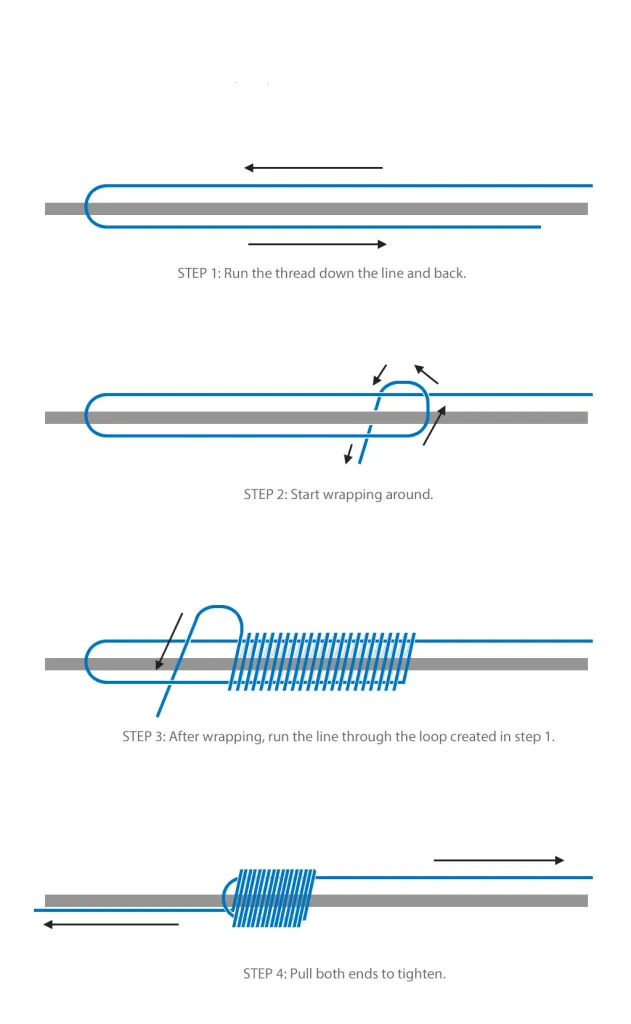How to tie Nock Sets, D-loops and Serving



Bowstring Maintenance.
Bowstring maintenance is essential for archers to ensure optimal performance and longevity. Here are some tips to keep your bowstring in top shape:
- Regular Inspection:
- Check for Fraying: Examine the entire length of the bowstring for any signs of fraying, loose strands, or wear.
- Inspect Nocks and Serving: Inspect the nocks (where the arrow attaches) and serving (the wrapped portion) for damage or wear.
- Cleaning:
- Remove Dirt and Debris: Use a soft cloth or a specialized bowstring cleaner to wipe away dirt, dust, and debris.
- Avoid Harsh Chemicals: Do not use harsh chemicals or solvents that could weaken the string material.
- Waxing:
- Apply Bowstring Wax: Regularly apply a high-quality bowstring wax to keep the fibers lubricated and prevent drying out.
- Focus on Serving Areas: Pay extra attention to the serving areas (where the string contacts the bow and the nocks) as they experience the most friction.
- Twisting and Straightening:
- Twist the String: If your bowstring becomes uneven or develops twists, gently twist it back into alignment.
- Straighten the String: Ensure the string lies flat and straight along the bow limbs.
- Storage:
- Store Properly: When not in use, store your bow in a cool, dry place away from direct sunlight.
- Avoid Extreme Temperatures: Extreme heat or cold can affect the string material.
- Replacement:
- Know When to Replace: Even with proper maintenance, bowstrings wear out over time. If you notice significant fraying, stretching, or other issues, consider replacing the string.
- Consult a Professional: If you’re unsure, consult an experienced archery technician for advice.
Tying in the nock set.
Tying bow nocks is essential for proper arrow placement on the bowstring. Let’s explore a few methods for achieving this:
- Adjustable Nocking Point:
- Start by determining the desired nocking point height on your bowstring by using a bow square and white marker.
- Use serving thread to tie alternating double overhand knots or string serving at the chosen location.
- Cut any excess string off.
- To create a bottom nocking point, tie another nocking point below the initial one. The space between the two nocks will depend on the thinness of the arrow nock.
- Fixed Nocking Point:
- Clip your arrow (or just the nock) onto the string, ensuring the nock is against the nocking point.
- Tie an overhand knot or string serving just underneath the nock, leaving a tiny gap to avoid nock pinch.

Tying a D-Loop

To tie a D-loop in archery, follow these steps:
- Prepare the D-Loop Cord:
- Cut a length of D-loop cord (approximately 8 centimeters is a good starting point).
- Fray one end of the cord slightly.
- Gently heat the frayed end with a lighter until it catches fire.
- Blow out the flame and press the hot end onto a flat, non-flammable surface to form a mushroom shape.
- Repeat the process on the other end of the cord.
- Prepare Your Bow String:
- Ensure your bow string has a nocking point (one point is necessary, a second is optional).
- Position the Nocking Point:
- Curve the nocking point over the string, above the existing nocking point, with the bulge facing away from the riser.
- Loop the Cord:
- Pass both ends of the D-loop cord underneath the string and back through the loop of the cord.
- Pull one end of the cord until the loop tightens around the string. The mushroom shape should prevent it from pulling through the loop.
- Tighten the Loop:
- Pull the cord really tight to secure the loop.
- Create the Bottom Anchor:
- Loop the free end of the cord around the nocking point to start the bottom anchor for the D-loop.
- Push the cord under the string and back through the loop.
- Push the cord behind the string once again, then loop it back under itself, allowing the mushroom to catch inside the loose knot that has formed.
- Ensure Security:
- Tighten the knot and make sure it’s secure.
- Use D-loop pliers to firm up the knots.
- Leave enough space for the arrow nock.
Bowstring Serving
Bowstring serving is a critical aspect of maintaining your archery equipment. Let’s delve into the details:
- What Is Bowstring Serving?
- Serving refers to the use of an additional thread wrapped around the main bowstring at specific points.
- It serves several purposes:
- Abrasion Protection: Serving reinforces areas prone to wear, such as the nocking points where the arrow contacts the string.
- Loop Integrity: On looped strings (used in recurve bows and traditional longbows), serving keeps the two sides of the loop together.
- Types of Bowstring Serving:
- Center Serving: This serves as the nocking point for the arrow. It’s positioned in the middle of the string.
- Endloop Serving: Used for endless loop bowstrings, it secures the loop ends together.
- How to Serve a Bowstring:
- Starting the Serving:
- Use a serving jig (such as the AAE Pro String Server) to maintain consistent tension and spacing.
- Begin wrapping the serving thread around the string at the desired location (e.g., nocking point).
- Ensure the serving lays flat and evenly.
- Finishing the Serving:
- Here’s a trick called backserving:
- Instead of using an extra piece of string to pull the tail through, wrap the serving thread back over itself.
- This secures the end without additional material.
- Trim any excess thread neatly.
- Here’s a trick called backserving:
- Starting the Serving:
- Materials and Tips:
- Serving Material: BCY #62 serving material is popular due to its durability and performance.
- Regular Maintenance: Inspect your serving for wear and re-serve as needed.
- Online Resources: You can find tutorials and videos demonstrating proper serving techniques.

![]()
